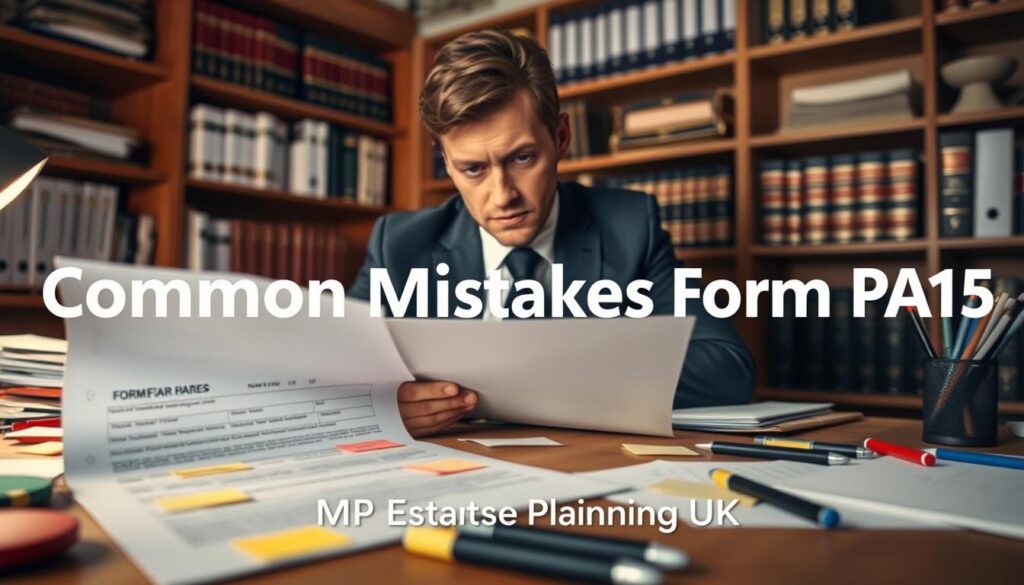Did you know that being named as an executor of a will can be both an honour and a burden? Many people find themselves in a situation where they need to step down from this role, but are unsure of the process.
Renouncing your position as an executor can be a significant decision, and it’s essential to understand the steps involved. In the UK, this process involves completing Form PA15. We will guide you through the process, explaining the legal requirements and what you need to do to renounce your executorship effectively.
Key Takeaways
- Understand the role of an executor and the implications of renouncing this position.
- Learn the steps involved in completing Form PA15 for executor renunciation.
- Discover the legal requirements for renouncing executorship in the UK.
- Find out what to expect after submitting your renunciation.
- Get guidance on seeking professional advice when needed.
Understanding the Role of an Executor
The role of an executor is crucial in managing the deceased’s estate, ensuring that their assets are distributed according to their will.
What Is an Executor?
An executor is an individual appointed by the deceased to administer their estate after they pass away. This person is responsible for carrying out the instructions left in the will, which can include managing assets, paying debts, and distributing inheritances to beneficiaries.
Duties and Responsibilities of an Executor
The duties of an executor are varied and can be complex. Some of the key responsibilities include obtaining a Grant of Probate, gathering in the assets of the deceased, paying off debts and taxes owed by the estate, and distributing the remaining assets according to the will.
| Duty | Description |
|---|---|
| Obtaining Grant of Probate | Confirming the executor’s legal authority to manage the estate. |
| Gathering Assets | Collecting the deceased’s property, money, and other possessions. |
| Paying Debts and Taxes | Settling outstanding debts and tax liabilities from the estate. |
| Distributing Assets | Allocating the remaining assets to beneficiaries as per the will. |
Common Reasons for Renunciation
Despite the importance of their role, some individuals may choose to renounce their duties as an executor. Common reasons for this decision include the complexity of the task, personal liability for any mistakes made during the administration of the estate, and the significant stress and time commitment required.
What Is Form PA15?
Form PA15 is a critical document for those who wish to renounce their role as an executor of a will in the UK. It is a formal, legal renunciation that allows an individual to step down from their executor duties permanently.
Overview of Form PA15
Form PA15 is specifically designed for the renunciation of probate executor or administrator rights. It is a straightforward document that requires the individual to provide their details and confirm their decision to renounce their role.
Using Form PA15 is the standard procedure for executor renunciation in the UK. It is essential to complete this form accurately to ensure the renunciation is processed correctly.
When Is It Required?
Form PA15 is required when an executor wishes to renounce their role permanently. This could be due to various reasons, such as personal circumstances, lack of time, or a conflict of interest.
For detailed guidance on the renunciation process, executors can refer to professional advice from solicitors specializing in probate law, such as those at Bishopslaw.
Key Information Included in Form PA15
The form requires specific information, including:
- The name and address of the deceased
- The details of the renouncing executor
- A statement confirming the renunciation of executor duties
It is crucial to fill out this form correctly to avoid any delays or complications in the probate process.
Eligibility to Use Form PA15
The process of renouncing executor duties using Form PA15 has specific eligibility criteria that must be met. To renounce their duties, an executor must understand the requirements and circumstances that affect their eligibility.
Who Can Renounce Executors’ Duties?
Any individual named as an executor in a will can renounce their duties using Form PA15, provided they have not intermeddled in the estate. Intermeddling refers to taking actions that demonstrate an intention to act as an executor, such as managing the deceased’s assets or dealing with their financial affairs. If an individual has not intermeddled, they are generally eligible to renounce their duties.
For more detailed information on executor duties and the renunciation process, you can visit https://mpestateplanning.uk/executor-duties-how-to-resign-from-a-will-in-the-uk/.
Are There Age or Legal Requisites?
There are specific legal requisites to renounce executor duties. The individual renouncing must be of sound mind and not have been coerced into making the decision. Additionally, they must not have previously accepted their role as an executor by intermeddling in the estate.
Executors who are minors (under 18 years old) cannot renounce their duties using Form PA15 until they reach the age of majority. In such cases, other arrangements may need to be made until the minor comes of age.
Special Circumstances Affecting Eligibility
Certain circumstances can affect an individual’s eligibility to renounce their executor duties. For instance, if an executor has already begun to administer the estate or has made decisions regarding the distribution of assets, they may be considered to have intermeddled. In such cases, renunciation may not be straightforward, and legal advice may be necessary.
Other special circumstances include situations where the executor is subject to a court order or has been declared bankrupt. In these cases, the individual’s ability to renounce their duties may be impacted, and professional advice should be sought.
| Eligibility Criteria | Description |
|---|---|
| Not having intermeddled in the estate | The executor must not have taken actions that demonstrate an intention to act as an executor. |
| Being of sound mind | The individual renouncing must have the mental capacity to make the decision. |
| Not being a minor (or considerations for minors) | Executors under 18 cannot renounce until they reach the age of majority. |

The Process of Renunciation Using Form PA15
Renunciation as an executor requires careful consideration and a clear understanding of the process, including the completion of Form PA15. When you decide to renounce your role, it’s essential to follow the correct procedure to ensure your decision is legally recognized.
Step-by-Step Guide to Completing PA15
Completing Form PA15 involves several straightforward steps. Here’s a guide to help you through the process:
- Step 1: Obtain Form PA15 from the UK Government’s website or a legal document supplier.
- Step 2: Fill in the form accurately, providing your personal details and the details of the deceased.
- Step 3: Clearly state your intention to renounce your executorship.
- Step 4: Sign the form in the presence of a witness, if required.
Ensuring that the form is completed correctly is crucial to avoid any delays in the process.
Required Documentation and Identification
When submitting Form PA15, you’ll need to provide certain documentation and identification. This typically includes:
- A copy of the will or grant of probate.
- Proof of your identity, such as a passport or driving license.
- Any other relevant documents as specified by the probate registry.
Having all the necessary documents ready will help streamline the submission process.
Submission Methods for Form PA15
Once you’ve completed Form PA15 and gathered the required documentation, you’ll need to submit it to the appropriate authority. The submission methods available include:
- Posting the form to the probate registry.
- Submitting the form in person, if allowed by the registry.
- Using an online submission portal, if available.
It’s essential to check with the probate registry for the most up-to-date information on submission methods and any specific requirements.

By following these steps and ensuring you have all the necessary documentation, you can efficiently complete the process of renouncing your role as an executor using Form PA15.
Consequences of Renouncing Executors’ Duties
Renouncing an executor role can lead to several outcomes that affect the estate administration process. It’s essential to understand these consequences to make an informed decision. We will explore the potential impact on the estate, possible legal implications, and how renunciation affects beneficiaries.
Impact on the Estate
Renouncing an executor role can delay the estate administration process. The remaining executors or newly appointed ones may need time to understand the estate’s details, potentially prolonging the distribution of assets.
Possible Legal Implications
There are legal implications to consider when renouncing an executor role. For instance, the renouncing executor may still be involved in legal proceedings related to the estate. It’s crucial to understand these implications to avoid any potential legal issues.
How Renunciation Affects Beneficiaries
Beneficiaries may be affected by the renunciation as it can lead to changes in the estate administration timeline. The new executor or remaining executors will take over the responsibilities, which may impact the beneficiaries’ expectations and timelines for receiving their inheritance.
| Aspect | Before Renunciation | After Renunciation |
|---|---|---|
| Estate Administration | Single executor or multiple executors working together | Remaining executors or new appointments take over, potentially delaying the process |
| Legal Responsibilities | Executors are legally responsible for estate administration | Renouncing executor’s legal responsibilities are transferred, but they may still be involved in certain legal matters |
| Beneficiaries’ Expectations | Beneficiaries expect timely distribution according to the will | Changes in executors may affect the distribution timeline, potentially delaying it |
For more information on the role of executors and the process of renouncing, you can visit our guide on how many executors you need for a.

Alternative Options to Renouncing Executor Status
Renouncing your role as an executor isn’t the only solution; there are alternative paths to consider. If you’re finding the responsibilities too burdensome or are otherwise unsuited to the role, it’s worth exploring other options before making a final decision.

Transferring Duties to Another Executor
One viable alternative is to transfer your executor duties to another person. This can be particularly useful if you have co-executors and can agree on who should take over your responsibilities. The process involves notifying the other executors and potentially obtaining the consent of the beneficiaries. It’s essential to review the will to see if it contains any provisions regarding the transfer of executor duties.
Transferring duties can be less complicated than renouncing, as it doesn’t necessarily involve the courts or the need to complete Form PA15. However, it’s crucial to ensure that the person taking over your duties is willing and capable of performing the role.
Applying for a Court Order
In some cases, you might consider applying for a court order to resolve any issues related to your executor role. This could involve seeking directions from the court on how to proceed or applying for the removal of an executor. This option is typically more complex and costly than renunciation, so it’s usually considered when there are significant disputes or complications.
Applying for a court order requires legal expertise, and it’s advisable to seek professional advice from a solicitor who specializes in probate law. They can guide you through the process and help you understand the potential outcomes and costs involved.
Seeking Professional Advice from Solicitors
Seeking professional advice is a prudent step when considering your options as an executor. A solicitor can provide you with tailored guidance based on your specific circumstances, helping you navigate the complexities of estate administration. They can also assist in communicating with co-executors, beneficiaries, and other relevant parties.
Professional advice can be invaluable in determining the best course of action, whether that’s transferring duties, applying for a court order, or proceeding with renunciation. By seeking expert guidance, you can ensure that you’re making an informed decision that aligns with your responsibilities and the best interests of the estate.
Timeline for Renouncing with Form PA15
Renouncing an executor role using Form PA15 involves a specific process with its own timeline. Understanding this timeline is crucial for managing expectations and ensuring a smooth transition.
Expected Processing Times
The processing time for Form PA15 can vary depending on several factors, including the complexity of the estate and the workload of the probate registry. Generally, it can take several weeks to a few months for the renunciation to be processed.
Typical Processing Times:
- Initial review: 2-4 weeks
- Processing and verification: 4-8 weeks
- Total: 6-12 weeks
What to Do While Awaiting a Decision
While waiting for the renunciation to be processed, it’s essential to stay informed and take necessary steps. Here are some actions you can take:
- Keep records of all correspondence with the probate registry.
- Be prepared to provide additional information if requested.
- Notify other executors or beneficiaries about the status of your renunciation.
Staying proactive can help minimize delays and ensure a smoother process.
Dealing with Delays or Complications
If you encounter delays or complications during the renunciation process, there are steps you can take to address them:
- Contact the probate registry to inquire about the status of your application.
- Seek professional advice from a solicitor if you encounter significant delays or issues.
- Consider requesting an update on the expected processing time.

By understanding the timeline and being prepared, you can navigate the process more effectively.
Common Mistakes to Avoid When Using Form PA15
To ensure a smooth renunciation process, it’s essential to understand the common mistakes associated with Form PA15. When filling out this form, executors must be meticulous to avoid delays or complications.
Incomplete or Incorrect Information
One of the most significant errors is providing incomplete or incorrect information on Form PA15. Ensure all details are accurate and complete to avoid having your renunciation rejected or delayed. Double-check the information provided, including your personal details and the details of the estate.
Some common issues include:
- Incorrect or missing signatures
- Inaccurate estate or deceased person details
- Failure to provide required identification
Not Informing Other Executors or Beneficiaries
Another crucial aspect is to inform other executors or beneficiaries about your decision to renounce. Transparency is key in maintaining trust and avoiding potential disputes. Failing to notify them may lead to confusion or even legal challenges.
It’s advisable to:
- Notify other executors and beneficiaries in writing
- Provide them with a copy of the Form PA15
- Discuss the implications of your renunciation

Ignoring Deadlines for Submission
Ignoring deadlines for submitting Form PA15 can result in unnecessary delays. Be aware of the timelines and plan accordingly to ensure your renunciation is processed in a timely manner.
To avoid this mistake:
- Check the submission deadlines with the relevant authorities
- Submit your form well in advance of the deadline
- Follow up if you haven’t received confirmation within a reasonable timeframe
By being mindful of these common mistakes, you can ensure a smoother process when renouncing your role as an executor using Form PA15.
Frequently Asked Questions about PA15
As you navigate the process of renouncing your executorship, you may have several questions regarding Form PA15. We aim to address some of the most common queries to help clarify the process.
How Long Is Form PA15 Valid?
Once submitted, Form PA15 is generally considered valid unless there are significant changes to the estate or the information provided. However, it’s essential to verify with the relevant authorities to ensure that your renunciation is processed correctly.
Can I Reconsider My Decision After Renunciation?
Reconsidering your decision after renouncing your executorship can be complex. In most cases, renunciation is considered irrevocable, meaning that once you’ve renounced, you cannot simply change your mind. It’s crucial to seek legal advice if you’re considering this step.
Here are some key points to consider:
- Renunciation is typically final and cannot be reversed easily.
- Legal advice is recommended before making any decisions.
- Court intervention may be necessary to reconsider your role.
What If I Change My Mind After Submission?
If you’ve submitted Form PA15 and then decide you want to retract your renunciation, acting quickly is vital. You should contact the relevant authorities and legal advisors to understand your options. However, as mentioned, renunciation is generally considered a permanent decision.
To summarize the key FAQs about PA15:
| Question | Answer |
|---|---|
| Validity of Form PA15 | Valid unless significant changes occur |
| Reconsidering Renunciation | Generally considered irrevocable |
| Changing Mind After Submission | Requires immediate action and legal advice |
Understanding the implications of renouncing your executorship and the use of Form PA15 is crucial. We hope this information helps clarify some of the common questions surrounding this process.
Resources for Executors in the UK
Managing an estate in the UK requires not only a deep understanding of one’s role as an executor but also access to the right resources and support. As an executor, you play a crucial role in ensuring that the deceased’s wishes are carried out as stated in their will.
Where to Find Form PA15
Form PA15 is a critical document for executors who wish to renounce their duties. You can obtain Form PA15 from the UK Government’s website or through the HM Courts & Tribunals Service. It’s essential to ensure you have the most current version of the form to avoid any delays in the process.
“Renouncing your role as an executor is a significant decision and should not be taken lightly,” says
a legal expert. “Having the right guidance and resources is key to making an informed decision.”
Helpful Websites and Contacts for Executors
Several websites and organizations offer valuable resources and support for executors in the UK:
- The UK Government’s website provides comprehensive information on the role of an executor and the process of renouncing duties.
- The Law Society offers a directory of solicitors specializing in probate and estate administration.
- STEP (Society of Trust and Estate Practitioners) provides resources and professional guidance for executors.
Having the right contacts and resources can significantly ease the burden on executors. It’s advisable to seek professional advice when dealing with complex estate matters.
Recommended Literature and Guides
For those seeking more detailed information, there are several guides and literature available:
- “The Executor’s Handbook” by David Royse offers practical advice for executors.
- The Law Society’s guide to probate and estate administration provides a comprehensive overview of the process.
These resources can provide executors with the knowledge and confidence to carry out their duties effectively.
Conclusion: Making an Informed Decision on Renunciation
Renouncing an executor role is a significant decision that requires careful consideration. As we have discussed, using Form PA15 is a crucial step in this process. To ensure a smooth renunciation, it’s essential to understand the key points to consider.
Key Considerations for Renunciation
When deciding to renounce, several factors come into play. We must consider the impact on the estate, potential legal implications, and the effects on beneficiaries. Understanding these aspects is vital to making an informed decision.
The Role of Legal Guidance
Seeking legal guidance is paramount when renouncing an executor role. Professionals can provide valuable insights and help navigate the complexities of the renunciation process. Sources emphasize the importance of expert advice to avoid potential pitfalls.
Final Considerations
In conclusion, renouncing an executor role using Form PA15 requires a thorough understanding of the process and its implications. By considering the key points and seeking legal guidance, individuals can make informed decisions that align with their responsibilities and obligations.


